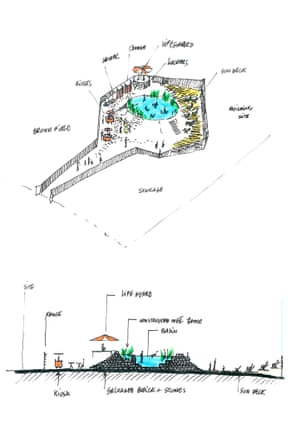I would never visit the seaside without having a swim. Fish and chips taste different when you have sand between your toes and a taste of sea salt on your lips. A seafront promenade looks different when you are bobbing around in the waves. Piers look different when you are swimming underneath them rather than walking along on top.
I once went on a swimming holiday to Malta, and I saw almost nothing of the island from land. I saw none of the major tourist attractions. Instead, I swam around the island, in coves and bays, along dramatic cliffs and in lagoons. I saw the land rising up out of the sea and large, imposing churches on faraway hills.
I’ve swum along the river Thames, watching cows and fields and reeds drift by, marvelling at the posh houses beyond the lawns. Being submerged in water, with your eyes at water level, changes your perspective. There is something about being submerged and unclothed that makes a swimmer small and vulnerable, and invisible. It heightens your responses to your environment.
Being in water in the city is no different.
For the past few months, I’ve been hearing rumours of a mysterious outdoor swimming venue that is to be built near the Guardian’s offices in King’s Cross, north London. The rumours were slippery and elusive and oh so exciting. Someone somewhere mentioned “the King’s Cross Pond Club”. It was tantalising in its secret exclusivity. Just when I thought I knew a bit more, my sources went cold, faded away, and I was none the wiser.
Then, two months ago, on a dark, wet and cold night, I saw a planning notice stuck to a lamp-post on a busy concourse outside King’s Cross train station. A planning notice for an outdoor swimming pond! Was it really going to happen? Was there really going to be an outdoor swimming space in King’s Cross – one of the most fast-moving and dramatic redevelopment sites in London?! A pond? Wow.
In the spring of 2015, King’s Cross, whose skyline is populated by cranes and the concrete beginnings of new high-rise buildings, will quietly offer adventurous swimmers a new urban swimming experience. Nestled between several large building sites at the end of Cubitt Park, just north of Regent’s Canal, the Kings Cross Pond Club will be a new kind of hybrid swimming experience: a synthetic, unheated swimming pond, filtered by plants and surrounded by nature. The project will offer swimmers a chance to swim in a changing landscape – in terms of the landscaping around the immediate pond, and the changing landscape of King’s Cross and its new, swanky, high-rise buildings. The pond will also be an experiment in creating a small-scale, self-sustaining ecosystem.
The project is officially called “Of Soil and Water: King’s Cross Pond Club”. The water in the swimming pond will be purified by natural processes, using wetland plants to clean the water and feed it water back into the pond. The number of people who will be able to swim in the pond on any given day will be restricted, so as to maintain a careful balance of what nature can regenerate. Hence the emphasis on a “club” – users of the pond will be entering a kind of implicit contract to be aware of the balance that is being achieved.
The pond, created in collaboration between Ooze architects (Eva Pfannes and Sylvain Hartenberg) and artist/architect Marjetica Potrč, is part of a series of art events commissioned by King’s Cross Central Limited Partnership. Ooze’s other work includes Água Carioca, a creative solution to the problem of sewage polluted waters in Brazil, which uses plants to help create a closed water system. Água Carioca is a self-sufficient and small-scale water management system that is being rolled out to the favelas around Rio de Janiero. Ooze is concerned with humans’ balance with nature and the responsibility of us all to create sustainable spaces.
Ooze says that the visitors to the pond will be entering “a living laboratory where they are aware of their relationship with nature, and about consequences of their interactions with nature”. They want them to take responsibility for that relationship. The landscaping around the pond will also be experimental and will “evolve and is designed to show a micro-landscape in the becoming; the succession of the different stages of natures related to different soils and waters. The experience of visitors will change continuously within the 18 months.”
Swimmers will undoubtedly be required to think about their relationship with nature, but also the city as well.

The juxtaposition of a natural swimming venue in such an urban environment thrills me. Even if it is sited in a small park, there is no denying that this pond will be a part of the fast-changing environment of the surrounding building sites, as well as the developing ecosystem that encloses it.
We steel ourselves for the city: encase ourselves in cars; block out the noise of traffic with headphones; present ourselves with hard city faces; don’t look at or talk to strangers. The city can be a harsh environment and we put up barriers to adapt. Instead, this project will require us to strip ourselves down till we feel most vulnerable, temporarily shrugging off that hard exterior, and immerse ourselves in the water. And then look up.
The changing skyline, the noise of building sites and cars, and no doubt the hardness of the city will still be there, but perhaps we might look at them and respond to them differently from the pond. And if our response to the urban environment changes, perhaps our relationship to the natural side – to the changing and developing landscape – will change and soften too. I can’t wait to join the club.
Source: Read Full Article
